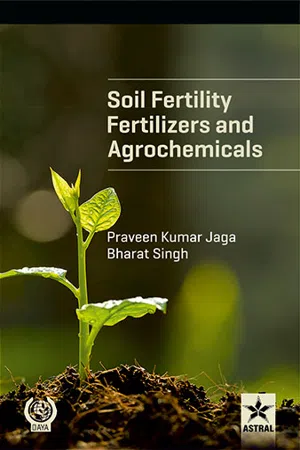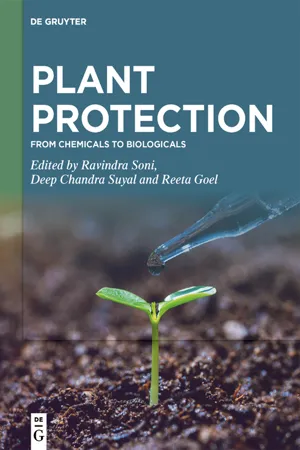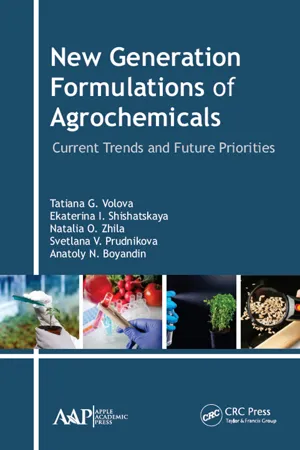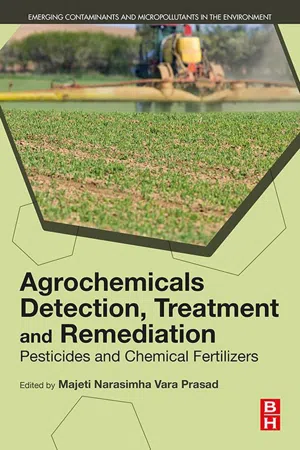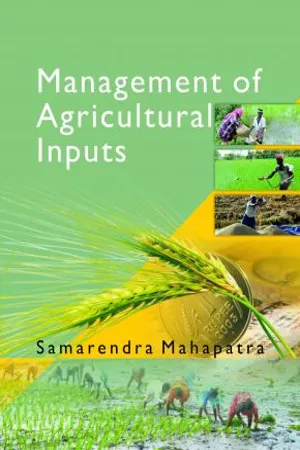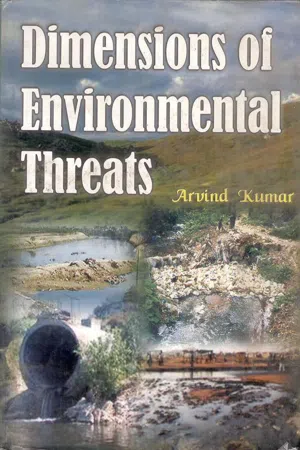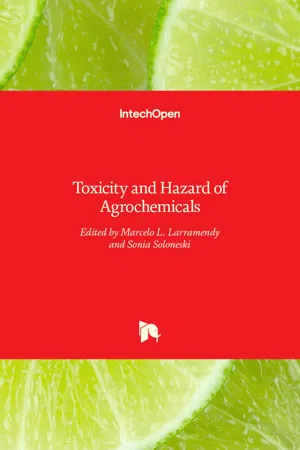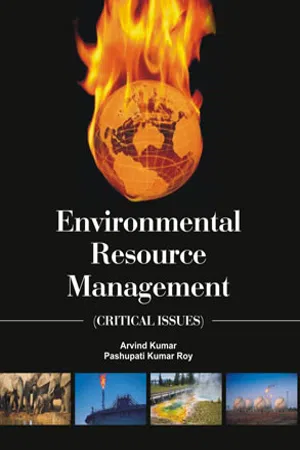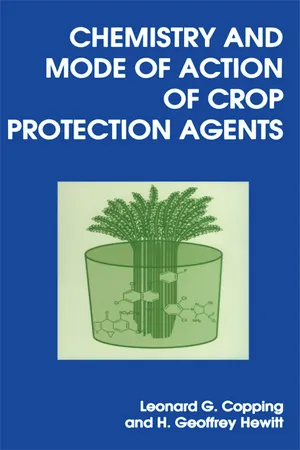Geography
Agrochemicals
Agrochemicals are chemical products used in agriculture to enhance crop production and protect plants from pests, diseases, and weeds. They include fertilizers, pesticides, and herbicides. While agrochemicals can increase agricultural productivity, their use also raises concerns about environmental and human health impacts, soil degradation, and water pollution.
Written by Perlego with AI-assistance
Related key terms
1 of 5
11 Key excerpts on "Agrochemicals"
- eBook - PDF
- Jaga, Praveen Kumar(Authors)
- 2021(Publication Date)
- Daya Publishing House(Publisher)
5: Introduction to Agrochemicals Agrochemical or Agrichemical a concentration of agricultural chemical is a generic term for the various chemical products used in agriculture. In most cases, agrichemical refers to the broad ranges of pesticide including insecticides, herbicides, and fungicides. It may be also include synthetic fertilizers, hormones and other chemical growth agents and concentrated stores of raw animal manure. Many agrichemical are toxic and agrichemicals in bulk storage may pose significant environmental and or health risks, particularly in the event of accidental spills. In many countries, use of agrichemicals is highly regulated. Government issued permits for purchase and use of approved agrichemicals may be required. Significant penalties can results from misuse including improper storage resulting in spillage. On farms proper storage facilities and labeling, emergency clean up equipment and procedures and safety equipment and procedures for handling, application and disposal are often subject to mandatory standards and regulations. Usually the regulations are carried out through the registration process. Pesticides are chemicals that are used in agriculture for control of pests, weeds and plant diseases. The chemicals natural and man-made have become an integral part of the human life. FAO defined pesticide as any substances or mixture of substances intended for preventing, destroying, or controlling any pest, including vectors of human or animal diseases unwanted species of plants or animals causing harm during or otherwise interfering with production, processing, storage, transport or marketing of food, agricultural commodities, wood and wood products, or stuffs, which may be administered to animals for the control of insect arachnids or other pests in or their bodies. - eBook - ePub
Plant Protection
From Chemicals to Biologicals
- Ravindra Soni, Deep Chandra Suyal, Reeta Goel, Ravindra Soni, Deep Chandra Suyal, Reeta Goel(Authors)
- 2022(Publication Date)
- De Gruyter(Publisher)
The market size of Agrochemicals is expected to reach $336.4 billion by the end of 2026, registering a compound annual growth rate of 4.2%. India, being the fourth largest producer of Agrochemicals, is succeeded globally by the USA, Japan, and China. United Phosphorus Ltd, Bayer CropScience Ltd, Rallis India Ltd, Gharda Chemicals Ltd, Syngenta India Ltd, BASF India Ltd, and so on are some of the top players who have dominated the market. These companies control almost 80% of the market share. If one is to look at the global population trend, it is of extreme importance that in order to feed the global population, it becomes vital to increase the production of crops within the present arable land. This is where the Agrochemicals can play an important role in this sector by assisting farmers in enhancing their crop quality as well as quantity. New developments such as integrated pest management, precision farming, and off-patent products are shaping the outlook of agricultural chemical industry. Not only these are threat to agrochemical industries’ long-term revenue targets, long-term disruptions like genome editing, food waste management, improvements in animal feed digestibility, decreasing biofuel demand, and the growing popularity of indoor farming also put a question mark on the brighter future of the sector. Having said that, the future of Agrochemicals still looks bright and worth the risk, considering global population growth, growing imperative to protect against crop losses and increase yields, and rising consumer demand for sustainably produced foods. Will leading agrochemical companies eventually increase their exposure to long-term disruptive trends and unfamiliar markets? There are no easy answers, but with growth and opportunity on the horizon, agrochemical companies will have many strategic options to consider as a promising future for the agricultural chemistry industry unfolds.1.1 Introduction
Agrochemicals are chemically or biologically engineered formulations made available to improve the outcoming yield as well as the quality of crops produced. The two major categories classified under Agrochemicals are fertilizers (which are used to add required nutrients to enhance plant as well as soil health) and pesticides (which protect and support the plants to fight against biological stresses, namely, weeds, pests, and insects compromising their optimum growth) [1 ].With the spread of agriculture throughout various world geographies, agrochemical application has often altered with the upward and downward shift observed in different physical and nonphysical factors affecting agrochemical application. The worldwide agrochemical sector was valued at $231 billion in 2020, and it is predicted to increase at a compound annual growth rate (CAGR) of 4.0% over the next 5 years (2021–2026). The market for herbicides is a largely contributing market in the pesticide segment. The use of Agrochemicals is found to be exceptionally high for cereals and grains since they cover a vast area for cultivation across the globe [2 ] (Figure 1.1 - eBook - ePub
New Generation Formulations of Agrochemicals
Current Trends and Future Priorities
- Tatiana G. Volova, Ekaterina I. Shishatskaya, Natalia O. Zhila, Svetlana V. Prudnikova, Anatoly N. Boyandin, Tatiana G. Volova, Ekaterina I. Shishatskaya, Natalia O. Zhila, Svetlana V. Prudnikova, Anatoly N. Boyandin(Authors)
- 2019(Publication Date)
- Apple Academic Press(Publisher)
CHAPTER 1Agrochemicals: USAGE AND ASSOCIATED ENVIRONMENTAL ISSUES
The rapid development of chemistry and intensive farming have facilitated the production and use of a vast variety of chemicals intended for protecting crops from weeds, pests, and pathogens. Modern intensive farming is impossible without pesticides. The global losses of potential yields caused by pests reach 37%: 13% of them are due to insects, 12% due to weeds, and 12% due to diseases. The annual losses are assessed at US$2000 billion (Oerke, 2006; Pimentel, 2009). However, pesticide build-up in the biosphere, via accumulation and concentration in the food chains of biota in agroecosystems and natural ecosystems, poses a global environmental threat (Hansen, 2004; Kaplin, 2007). Only a small part of pesticides in the environment reach their goal; the remaining pesticides kill beneficial organisms, accumulate in biological objects, destroy the balance in natural ecosystems, and contaminate soil, water, and air. The scale of pesticide application is very large and keeps on growing.The Food and Agriculture Organization (FAO) and the World Health Organization (WHO), in the Codex Alimentarius (1963), defined pesticide as any substance intended for preventing, destroying, or controlling any pest, including vectors of human or animal disease, unwanted species of plants or animals, causing harm during or otherwise interfering with the production, processing, storage, transport, or marketing of food, agricultural commodities, wood, and wood products or animal feedstuffs, or substances that may be administered to animals for the control of insects, arachnids, or other pests in or on their bodies. The term includes substances intended for use as a plant growth regulator, defoliant, desiccant, or agent for thinning fruit or preventing the premature fall of fruit. Also used as substances applied to crops either before or after harvest to protect the commodity from deterioration during storage and transport. - eBook - ePub
Agrochemicals Detection, Treatment and Remediation
Pesticides and Chemical Fertilizers
- Majeti Narasimha Vara Prasad(Author)
- 2020(Publication Date)
- Butterworth-Heinemann(Publisher)
Chapter 16African perspective of chemical usage in agriculture and horticulture—their impact on human health and environment
Aliyu Ahmad Warra1 and Majeti Narasimha Vara Prasad2 ,1 Centre for Entrepreneurial Development, Federal University, Gusau, Nigeria,2 School of Life Science, University of Hyderabad, Hyderabad, IndiaAbstract
The chemical burden on natural ecosystems is increasing globally due to agricultural industrialization. Agrochemicals (fertilizers and pesticides) play an important role in agriculture and horticulture and have been widely used for crop protection and increasing productivity in Africa. Reducing the losses from crop pests will help increase food availability and boost economic growth in sub-Saharan Africa. Chemical pesticides, regardless of their inherent hazard, are used intensively in the fast-changing agricultural sector. Pesticides are among the major technologies used in the management of field and postharvest losses due to pests. This accounted for the growing demand for effective alternatives that present low health risks and conserve ecosystems and biological diversity. Commercialization of horticulture farming, expansion of farms, and the practice of monoculture favor the proliferation of pests, which in turn increases the need for pesticides. Mineral fertilizers have never been used as much as they are today, and in developing countries, they are experiencing a renaissance. But the efficacy of mineral fertilizers and the problems they entail have long been a matter of contention. The hazards associated with agrochemical use are real. With the strong lobbying power of environmental groups, Agrochemicals are now viewed as a sensitive issue. This chapter is centered on the use of Agrochemicals in agricultural and horticultural practices in Africa with particular emphasis on the potential impact on human health and environment; some preventive measures and regulatory issues are also discussed. - eBook - PDF
- Samarendra Mahapatra(Author)
- 2021(Publication Date)
5.5 Agrochemicals Linked to Productivity India's agricultural production has shown a growth of 2.7% p.a. over the last 40 years, contributing today to one fifth of its GDP. From a mere 52 million tones in 1951-52, the food grain production in 2005-06 has increased to 210 million tones. However, differences in soil fertility and corresponding agricultural growth as well as unreliable weather conditions across the country, have resulted in an overall wide disparity in terms of regional agricultural produce. This has further been worsened by farmer illiteracy, backwardness and poverty. Notwithstanding, an important role in the overall agricultural growth and productivity in India has been due to the agrochemical industry. Through government support and assistance, farmers have been encouraged to adopt better techniques of production, advanced technology, latest machines, improved seeds, fertilizers, chemicals and all this has led to spectacular increases in yield of crops. The agrochemical market in India has grown over the decades, with the farmers having been inclined toward adoption of Agrochemicals to protect their crops. Agrochemicals defend crops against insects, pests, disease, and weeds before and after harvesting. They play a major role in improving soil fertility, protecting crop produce and raising productivity. Agronomy revolves around the optimum application of Agrochemicals and that in turn greatly influences the production of various crops. The case speaks about an agrochemical company, Krishna Pvt. Ltd., dealing with manufacture and production of Agrochemicals and pharmaceuticals. While the company had a history of growth and success Marketing of Agrochemicals 263 and had begun to control a substantial market share of Agrochemicals in the country, the year 2000 onwards, witnessed a deterioration of sales. - eBook - ePub
The Economics of Agro-Chemicals
An International Overview of Use Patterns, Technical and Institutional Determinants, Policies and Perspectives
- G.A.A. Wossink, G.C. van Kooten, G.H. Peters, G.A.A. Wossink, G.C. van Kooten, G.H. Peters(Authors)
- 2018(Publication Date)
- Routledge(Publisher)
1 Introduction to Agro-chemicals UseG.A.A. Wossinka , G.H. Petersb and G.C. van KootencIntroduction
Efficiency gains in agricultural production as a result of agro-chemicals (chemical pesticides and fertilizers) are reported to be significant. That is obviously important given the projected growth of world population, though in many countries there is an increasing concern about the public health risks and negative environmental effects of agro-chemicals application. These contrary positions – the positive contribution of agro-chemicals to food production versus their real and perceived negative impacts on health and the environment – justify a careful analysis of the role of agro-chemicals within sustainable agriculture. For agriculture to become more sustainable, the relationships between agro-chemical use, crop response and environmental quality and human health need to be studied. Many factors are involved in these interrelationships and their dynamics: agro-ecology and climate, crops and rotations, socioeconomic conditions, farmers’ knowledge and their preferences, the influence of research, education and extension, and developments within the chemical industry.Against this complex background a conference on the economics of agro-chemical use was held under the aegis of the International Association of Agricultural Economists in April 1996 in Wageningen, The Netherlands. The objective was to bring together experts from both industrialized and developing countries to exchange experience and information. This book presents a selection of the papers presented at the conference.This first chapter presents an introduction to agro-chemical use. Information is provided on the growth of fertilizer and pesticide use and on their productivity during recent decades both by region and globally. Environment and health problems related to agro-chemical use are described and their nature is indicated. Finally, we highlight some of the most urgent research questions and major findings emerging from the conference. The text contains many references to the basic literature which readers might find useful as further reading. - eBook - PDF
- Kumar, Arvind(Authors)
- 2021(Publication Date)
- Daya Publishing House(Publisher)
2 BIOAgrochemicals TOWARDS GRADUAL ALLEVIATION OF SYNTHETIC CHEMICALS Y.C. Tripathi, Sushma Singh, G. Tripathi & A. Kumar ABSTRACT The ever-expanding pollution and consequently increasing pressure on food production demand high agricultural productivity, concurrent with adequate increase in crop yield by use of fertilizers and protection of crops from damaging insect pest and diseases. Ambitious use of synthetic Agrochemicals in ecosystem caused variety of deleterious effects to the environment and human health. Inefficient uptake of applied fertilizers resulted in the hardening of soil thereby making it less productive. Leaching of pesticides to groundwater or nearby rivers, simultaneous non-selective killing of pest, accidents with toxic pesticides, pesticide residues of food crops and the disappearance of certain vertebrates have become more or less synonymous with modern intensive agriculture. The problem of hazardous consequences of the use of synthetic This ebook is exclusively for this university only. Cannot be resold/distributed. Agrochemicals may be solved effectively by developing and practising fertilizers and pesticides of biological origin. Use of bioAgrochemicals in agro-ecosystem is now emerging as one of the prime device to increase agricultural productivity and to protect crops from insect pest and diseases in an eco-friendly manner. BioAgrochemicals are being preferred over their synthetic counterparts on account of their low mammalian toxicity, ecofriendliness and non-hazardous characteristics to non-target subjects. In this article, scientific approaches, their advantages, common characteristics, potentiality and eco-friendly nature of bioAgrochemicals have been reviewed. Keywords : Synthetic Agrochemicals, Hazards, Global concern, Biofertilizers, Biopesticides. Introduction All forms of lives are sensitive to their surrounding environment. - eBook - PDF
- Marcelo L. Larramendy, Sonia Soloneski, Marcelo L. Larramendy, Sonia Soloneski(Authors)
- 2015(Publication Date)
- IntechOpen(Publisher)
Recommendations are often case-specific and need to be based on sound science as well as common sense principles. The chapter concludes with a summary of issues that need to be considered for improving risk assessments of Agrochemicals. Keywords: risks, residues, pesticides, evaluation, methods, review 1. Introduction The enormous amount of chemical contaminants that are currently found in air, soil, water and sediments of our planet, mostly as a result of human activities [1], call for an evaluation of their risks to the web of life. The contaminants that potentially result in adverse biological effects – whether at individual, population, community or ecosystem level – the so-called pollutants, are of concern [2]. For obvious reasons, pollutants that relate to our food resources are of particular interest and require priority in risk assessment. Among the latter chemicals are those used in agricultural production, also called Agrochemicals, which include pesticides of various kinds, plant growth regulators, repellents, attractants and fertilisers. These chemi‐ cals are intentionally added to the environment for controlling pests and diseases of crops, requiring an accurate assessment of the maximum amounts that can be applied. Because of their huge market in all continents, Agrochemicals are among the most common pollutants in one fifth of the Earth’s land [3]. Also, given the high toxicity of most insecticides, herbicides and fungicides to their target and nontarget organisms, their negative impacts on the environment cannot and must not be ignored. Indeed, pesticides constitute one of the main drivers of population decline in some wildlife species [4]. Therefore, proper evaluations of the risk that pesticides and other Agrochemicals pose to organisms and ecosystems should be conducted in a scientific manner. - Kumar, Arvind(Authors)
- 2021(Publication Date)
- Daya Publishing House(Publisher)
Chapter 26 Soil and Groundwater Pollution by Agrochemicals: A Review D.S. Kler, Navneet Kaur and R.S. Uppa l Department of Agronomy and Agrometeorology, Punjab Agricultural University, Ludhiana – 141 004 ABSTRACT Increased consumption of Agrochemicals for attaining self-sufficiency in the developing countries, resulted in soil and groundnut pollution. Agrochemicals i.e. pesticides and herbicides disrupts the activity of soil microorganisms like bacteria, fungi, algae and nematode which affect the nutritional quality of soils. These Agrochemicals affect the important biological processes (Ammonification, Nitrification, Denitrification and Nitrogen fixation) and enzymatic activities of soil. The leaching of nitrogenous fertilizers to the groundwater also has many biological consequences. These Agrochemicals affected the health of human beings. To achieve the desired goal. We will have to take special measure to solve the problems of the future. Use less persistent pesticides, run off, volatilization and leaching may be reduced to the maximum extent possible. To achieve the desired goal we will have to take special measures to solve the problems of the future considering future ecology more important than present economy. Introduction An increased scale of man’s agricultural, industrial and social activities has brought with it an undesirable change in the chemical, physical and biological properties of the environment. According to Miller (1991), “Any undesirable changes in the characteristics of the air, water, soil and food that This ebook is exclusively for this university only. Cannot be resold/distributed. can adversely affect the health, survival or activities of humans or other living organisms is called pollution”. The developing countries for attaining self-sufficiency made massive investments in the development of new varieties of crops, fertilizers, pesticides and agricultural machinery, storage techniques and marketing facilities.- Leonard G Copping, H Geoffrey Hewitt(Authors)
- 2007(Publication Date)
- Royal Society of Chemistry(Publisher)
As these countries are the richest nations it is unlikely that this will change within the foreseeable future. This again means that agrochemical companies will target established markets in wealthy countries, but with an eye on the situation in large potential markets such as China (population 1200 million) and India (population 900 million). 3 BIOLOGICAL SCREENING - DISCOVERY AND DEVELOPMENT OF A NEW AGROCHEMICAL So far, it has been established that there is a very large market for crop protection agents globally and that these markets are dominated with crops such as wheat, barley, maize, soybeans, rice, cotton, grapes, top fruit and total weed control in countries and regions such as the USA, 12 Chapter 1 Western Europe and Japan. The opportunities in South and Central America are beginning to be realised and, as the economics of Eastern Europe and the former Soviet Bloc improve, there is considerable potential in these areas as well. Countries such as India and China will also become significant opportunities for the development of agrochem- icals but the restraints on trade that include such things as non- conformity with international patent law (although the introduction of GATT legislation - General Agreement on Tariffs and Trade - and acceptance into the league of friendly trading nations is changing this) has restricted penetration into these markets. For more details of the approaches to screening and early field testing see Copping et al. l1 and Copping. l2 So how do companies search for new Agrochemicals? In simple terms, each company has a list of key crop areas and a list of insects, pathogens and weeds that infest those crops. The targeted crops are usually those that command significant agrochemical input and the target pests, diseases and weeds are those for which there is an established market.- eBook - PDF
Herbicides
Advances in Research
- Andrew J. Price, Jessica A. Kelton, Andrew J. Price, Jessica A. Kelton(Authors)
- 2013(Publication Date)
- IntechOpen(Publisher)
Chapter 1 Agrochemicals and Bacterial Diversity in Cultivated Tropical Soils Joseph Addo Ampofo Additional information is available at the end of the chapter http://dx.doi.org/10.5772/54963 1. Introduction 1.1. General Agrochemicals provide yield protection, prevent and cure crop disease, provide insulation to reduce energy use and provide countless other benefits that increase the standard of living for civilization as a whole. While the chemicals industry has made good progress reducing its overall environmental footprint, chemicals can also create a negative impact on human health and the environment when their production and use are not managed responsibly (Edwards, 1975; Tu, 1990; Zulalian, 1990). 1.2. Agriculture in Ghana Urban food needs is increasing in developing countries, including Ghana (Figure 1), with growing populations. Increasingly vegetables are grown in urban and peri-urban areas to meet this demand. Agriculture has been Ghana’s most important economic sector over the years, employing more than 60% of the national work force, mainly in the small landholders on formal and informal basis (Gerken et al , 2001) and accounting for about 40% of the total GDP and export earnings. Ghana has climatic zones that range from dry savanna to wet forest and run in east-west bands across the country. Agriculture crops including yams, grains, cocoa, oil palms, kola nuts and timber, form the base of Ghana’s economy. Compared to this, the contribution of the more traditional vegeta‐ bles such as okra, pepper, tomato, onion and egg plants to the agricultural GDP is low. However, considering their contribution to agricultural GDP and the land area devoted to the cultivation of all crops, the traditional vegetables produce more value per area.
Index pages curate the most relevant extracts from our library of academic textbooks. They’ve been created using an in-house natural language model (NLM), each adding context and meaning to key research topics.
